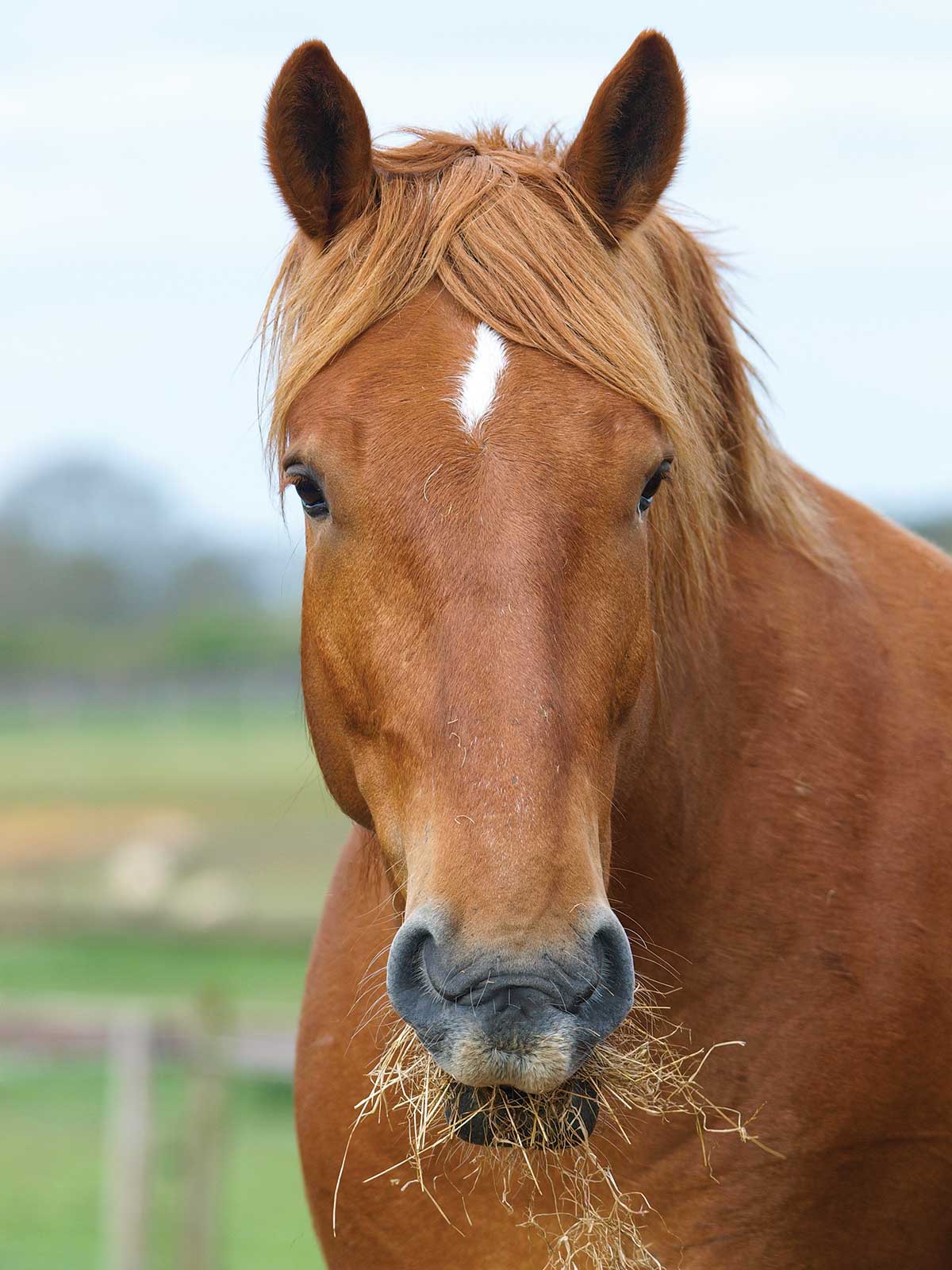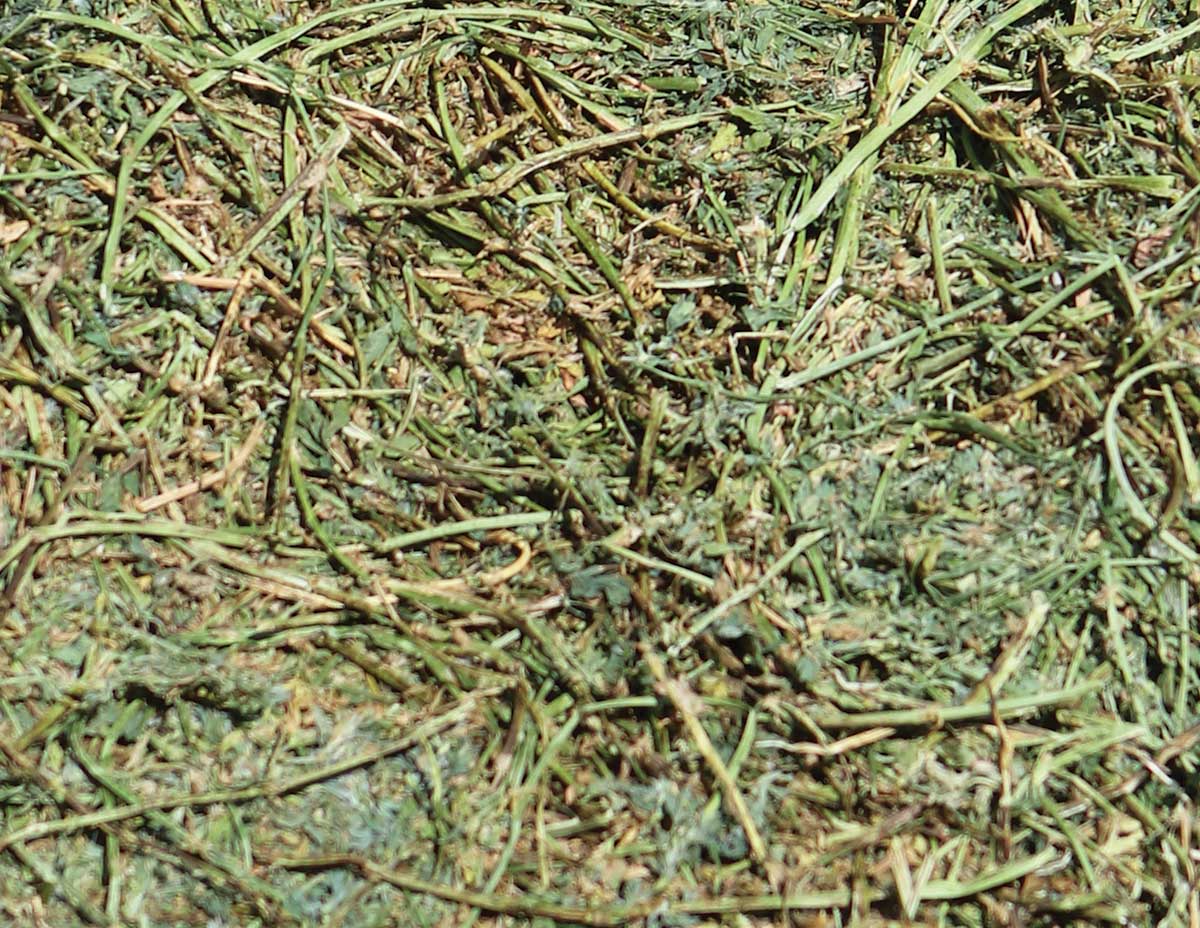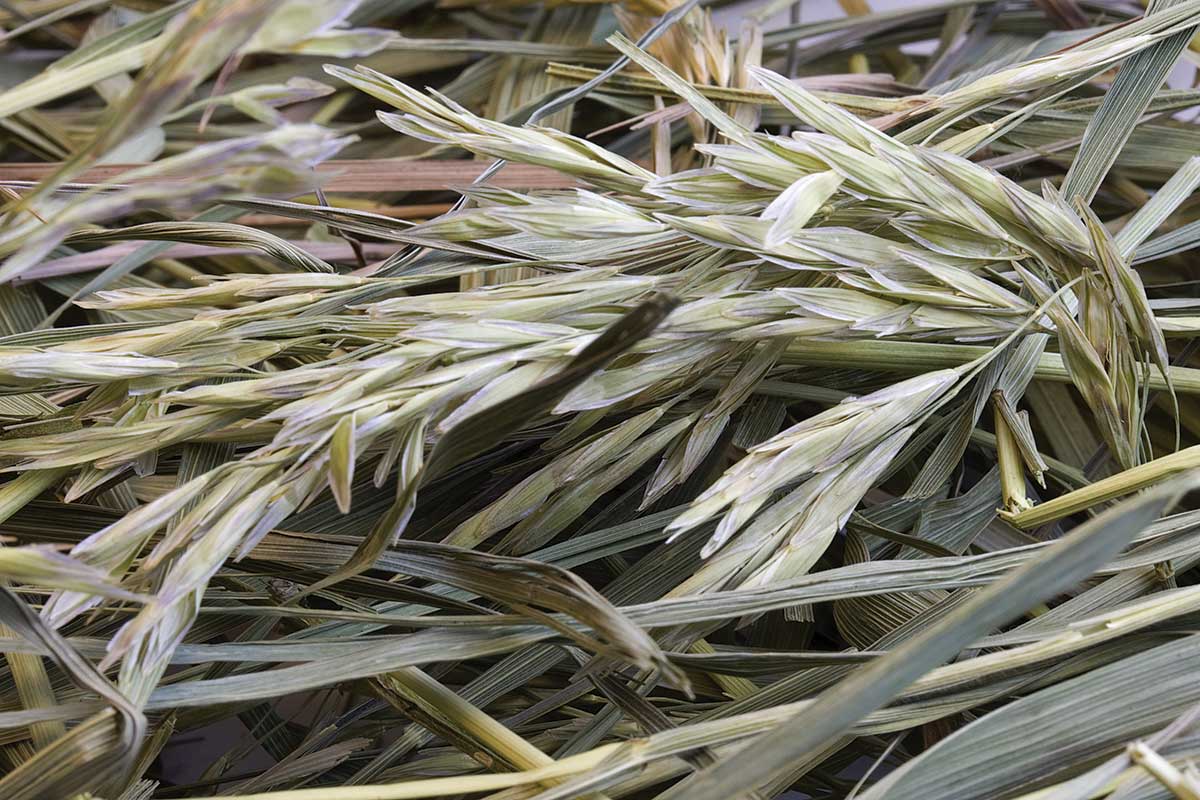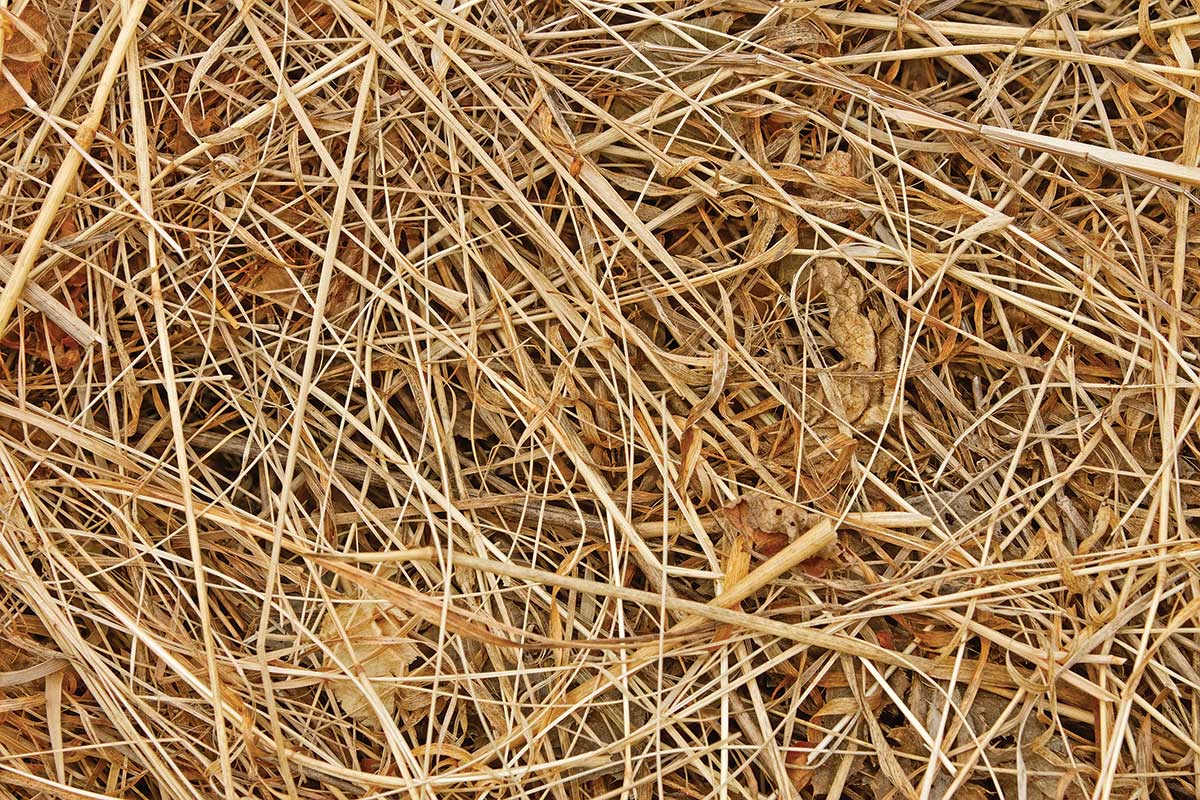
I’m standing in a barn with my client and her obese horse. I explain why it’s important that she find hay with a low-carbohydrate content to minimize the risks of a founder episode, while still providing adequate nutrients.
“Look carefully at the hay analysis,” I tell her. “You want to find something with an NSC (non-structural carbohydrate) value of less than 10 percent, and a protein level of at least 10 percent. If the protein level is low, you can make that up with a supplement.”
But then she leads me to the hay barn, where she shows me her options—green, leafy alfalfa; a brown, stemmy-looking orchard grass; and a greener timothy with obvious seed heads.
“These are my only choices,” my client tells me. “The barn owner won’t let us bring in outside hay. And she orders hay monthly from a local supplier, so by the time I get a hay analysis done, we’ll probably have a different batch.”
Sound familiar? If so, you’re not alone. While hay analysis might give you all of the information you need to choose the perfect hay for your special-needs horse, it simply isn’t available all the time. And when it’s not, your only choice may be to look at what’s available, and make a choice based on what you see.
I’m here to help you learn how to play the odds when choosing hay for your horse. First, I’ll give you typical nutritional information for different types of hays. Then, I’ll explain other factors that can impact nutritional values. Finally, I’ll offer examples to help you choose a hay for your horse based on what you see.
Forage Facts
The average horse consumes 2 to 2.5 percent of his bodyweight in forage each day. This means your 1,000-pound horse should have between 20 and 25 pounds of hay each day, assuming he doesn’t spend time on pasture. With this in mind, why do you spend hours agonizing over the best concentrate to meet your horse’s needs, yet simply “settle” on what’s available when it comes to hay?
The right hay can provide 100 percent of the required nutrients for many horses. And in a perfect world, your horse would be nibbling on long-stem forage (pasture or hay) 24-7, just as he would in the wild. Eating all day long not only ensures that his gastrointestinal tract functions properly, but also keeps his mind at ease.
But a perfect world is sometimes unrealistic. If you can’t meet all your horse’s nutritional needs with hay, he should have a minimum of 1 percent of his body weight per day in long-stem fiber. Studies show that when total ration particle size falls below one inch, colic risks increase and behavior vices, such as wood chewing, become more frequent.
Beyond the need for long-stem fiber, digestible energy (calories), protein content, and carbohydrate levels are three important components of your horse’s diet. Here’s a rundown of each one.
Digestible energy: The term “digestible energy” (DE) refers to calories per pound. In practical terms, the higher the DE, the less your horse will need to eat to keep him fit—not fat. The most practical way to evaluate your horse’s digestible-energy requirement is simply to watch his weight. Is he fat? He needs less. Is he thin? Feed him more. Exercising horses, pregnant and lactating mares, and growing youngsters will have higher energy needs than sedentary horses.
Protein: Protein requirements also vary among different types of horses. A sedentary horse or a horse in light work requires 10 to 11 percent protein daily, while a high-performance horse, broodmare, or growing youngster needs closer to 12 to 14 percent. How can you tell if your horse is protein-deprived? Visual clues include a noticeable lack of muscling along his back and topline along with a potbellied look.
But how much is too much? Contrary to popular belief, too much protein really won’t cause a problem for your horse. A high-protein diet may result in greater urine production and higher ammonia levels in the urine, but that’s more of a stall-cleaning nuisance than a health risk. And most higher-protein feeds also have higher digestible energy, meaning they provide a lot of calories.
Carbohydrates: Finally, carbohydrate content has gained quite a bit of attention in recent years, primarily because we’ve learned to recognize horses with health issues—such as insulin resistance and polysaccharide storage myopathy (PSSM)—can experience severe consequences when fed high-carbohydrate diets. Hay’s carbohydrate content can be expressed in three ways: (1) non-structural carbohydrates; (2) water-soluable carbohydrates; and (3) ethanol-soluable carbohydrates.
The term “non-structural carbohydrates” (NSC) refers to starch and sugars broken down in the small intestine and absorbed as glucose into the bloodstream, which is risky for a horse with a sugar-sensitive condition.
Nutrition “purists” prefer to look at water-soluable carbohydrates (WSC), which include simple sugars without starch, as well as ethanol-soluable carbohydrates (ESC), which help to separate out a specific type of sugar molecule called fructan (risky for a laminitis horse).
For practical purposes, if your horse is sugar-sensitive, your vet will recommend looking for an NSC value that’s less than 10 percent, although in many cases this is difficult to find. A WSC less than 10 percent is often a more reasonable goal.
The Big Three
When choosing hay, there are three key factors to consider: hay type, harvest conditions, and storage.
Factor #1: Hay Type
Geography is a major limitation when choosing hay. Where you live dictates which hay types are available. That said, you’ll most likely choose from three categories of hay: legume, grass, and cereal grain. Here’s how the most common options measure up, according to data collected over a 16-year period from Equi-Analytical Laboratories, providers of hay analysis for samples from around the United States.

Legume: Alfalfa hay is a common legume hay fed to horses and likely to be available in most areas in the United States. Other legume hays include clover varieties.
Digestible Energy: 1.193 mcal/lb
Protein: 21.257 percent
NSC: 11.004 percent
WSC: 9.178 percent

Grass: Most commonly timothy, orchard, Kentucky bluegrass, bromegrass, and tall fescue. Teff, a new type of grass hay, is touted to be an ideal choice for many horses (see sidebar at right). Nutritional values of grass hays vary greatly depending on harvest conditions.
Digestible Energy: 0.909 mcal/lb
Protein: 10.868 percent
NSC: 12.850 percent
WSC: 11.487 percent

Cereal Grain: Oat and barley are examples of cereal grain hays (a subset of grass). Oat hay is the most common option fed to horses.
Digestible Energy: 0.894 mcal/lb
Protein: 8.251 percent
NSC: 22.112 percent
WSC: 17.917 percent
On average, alfalfa hay is higher in protein than grass hay. In fact, grass hays can be found with less than 5-percent protein (inadequate even for a sedentary horse), while alfalfa rarely falls below 18 percent. Grass hays are especially variable depending on where and how they’re harvested and how they’re stored. You might be surprised to learn that grass hays are typically higher in carbohydrates than alfalfa—a risky proposition for a sugar-sensitive horse. Because of this, evaluation of grass-hay quality is especially important.
Finally, oat hay is typically low in protein and high in sugar content. Although it can be a good forage option for some horses, it may not be the best choice for a sugar-sensitive horse and is likely to require protein supplementation to meet basic nutritional needs.
A WORD ABOUT COLORAlthough we all love to see beautiful, green hay, color isn’t as reliable an indicator of hay quality as we might think. While it’s true that bright-green hay generally means it was properly cured, it doesn’t always tell you about the stage of maturity at harvest or quality of the hay. Brown, early-maturity hay could have better nutrient quality than green, later-maturity hay. In fact, if you’re looking for low-carbohydrate hay, brown, rained-on, early-maturity hay that’s been properly cured may be the ideal choice! And keep in mind that many weed species are green, so inspect that green hay carefully.
Factor #2: Harvest Conditions
Beyond hay type, harvesting plays a major role in suitability for different horses.
Maturity: As hay matures, digestibility decreases and protein levels decrease. Non-structural carbohydrate levels also decrease. To determine maturity, look for leaves and small, tight “buds” on alfalfa, and few or small, soft seed heads on grass or oat hay. If you see purple flowers on alfalfa hay or large, coarse seed heads on grass or oat, the hay is more mature.
Thick, coarse stems also indicate hay is more mature, while hay that’s softer to the touch is likely less mature. (Tip: Was the hay grown in a rainy area of the country? If so, conditions may not be dry enough to harvest until later in maturity, which will impact nutritional value.)
Moisture Level: Does the forage have a musty smell? Do you see mold in the center of the bale? That might mean the hay was too moist when baled, which can contribute to respiratory issues. In a worst-case scenario, hay that’s baled too wet and has a very high moisture content might be more combustible and can be a fire hazard.
If hay is very dusty or brittle, it can mean the moisture content was too low when it was baled. Brittleness contributes to wastage—which means you’ll have to feed more to meet nutritional needs. Dusty hay can also contribute to respiratory issues.
Weather Conditions: What about rained-on hay? If hay was rained on in the field but dried prior to baling, non-structural carbohydrates will be leached away. In fact, rained-on hay (as long as it’s properly harvested) can be an ideal choice for a sugar-sensitive horse.
Cleanliness: If you see weeds or insects within a bale of hay, it probably isn’t the best choice for any horse.
Factor #3: Storage
The third factor that impacts hay quality and nutritional value is how it’s stored. Believe it or not, studies indicate that properly stored hay can maintain its nutritional value for at least three years, or even longer! Properly stored hay is kept indoors, stacked off the ground (on pallets), and stored in a cool environment.
Sunbleaching: Hay that’s yellow on the outside and green on the inside may be sunbleached, meaning it’s spent some time stored outside. A mild amount of bleaching can have minimal effect on nutritional value, and can happen due to a brief time in the sun immediately after harvest. Extensive bleaching may indicate a loss of nutritional value.
Mold: Do you see mold on the edges of the bales? This hay might’ve been stored directly on the ground, allowing moisture to wick up into the bales. This can result in as much as 50-percent wastage in addition to impacting nutritional value.
Pests: Do you seen evidence of rodent contamination? Hard as it can be to keep the mice and rats away, storing hay in a rodent-proof area is critical to maintain quality.
TEFF HAYTeff, a new type of grass hay that’s been introduced from Ethiopia, has garnered a lot of attention in the past few years. On average, this hay tends to be higher in protein and lower in non-structural carbohydrates than other grasses. Stage of maturity, harvest conditions, and storage will have the same effect on Teff hay as on other grasses, so inspect it carefully. But if hay analysis isn’t available and you’re trying to play the odds, Teff hay just might be the ideal choice for your sugar-sensitive horse.
Making a Choice
How can you make use of this information to choose the best hay for your horse? Let’s take a look at some hypothetical examples that might relate to your situation.
Lazy Larry
Larry is older, obese, and insulin-resistant.
Larry’s Needs: Larry requires a low-carbohydrate, low-calorie hay. He also needs adequate protein to meet his basic requirements.
Hay Choice: Later-maturity grass hay might be an option for Larry. It’s lower in digestible energy and non-structural carbohydrates to facilitate weight loss and reduce sugar risks. However, it could cause protein deficiency, which can be addressed by including a small amount of alfalfa hay with his ration. Good-quality, early-maturity Teff grass hay might also be a reasonable choice (see sidebar on page 105). And exercise—Larry needs to get to work!
Hacking Harry
Harry is a mature horse with a moderate work schedule. He has a chronic cough that seems to get worse at different times of the year.
Harry’s Needs: As long as his basic nutritional needs are met, it’s most important that Harry’s hay is dust- and mold-free to address his respiratory problems.
Hay Choice: An early-maturity, good-quality grass hay may be all that Harry needs. Protein and digestibility should be adequate, and sugar content isn’t a big concern. If oat hay is available but grass hay isn’t, Harry could probably tolerate an oat hay/alfalfa combination.
Prancing Polly
Polly is a fit and energetic performance horse, expected to work hard for several hours each day. She’s also highly stressed, and her weight is hard to maintain.
Polly’s Needs: Polly needs hay with high digestibility and at least 12 to 14 percent protein.
Hay Choice: Alfalfa hay should definitely be a part of Polly’s ration. It offers some additional benefits for performance horses living a high-stress lifestyle—its higher calcium content compared with other hays has a buffering effect on stomach acids and can reduce gastric ulcer risks. (Experts recommend feeding an alfalfa ration 30 to 60 minutes prior to exercise for maximum benefit.) Consider feeding Polly a ration that’s 50/50 alfalfa/early-maturity, high-quality grass hay.






